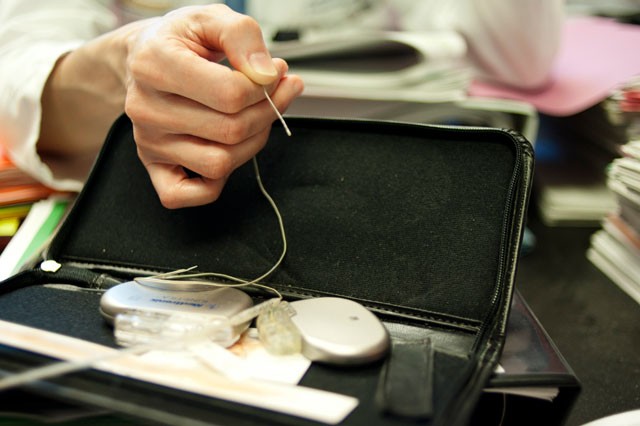A thin, flexible cable runs from a battery-powered transmitter implanted in the chest under the skin. It tunnels under the skin from the chest up to the neck before diving into the brain.
Pulses of electricity race constantly from battery to brain, altering the brainâÄôs activity in key areas.
This technique, deep brain stimulation, has been used as an effective therapy for movement disorders like ParkinsonâÄôs disease for more than a decade.
At the University of Minnesota, experts perform the surgery in hopes of improving patientsâÄô lives and to look for ways to improve and expand the therapyâÄôs use in the clinic.
âÄúIf you can go in there with electricity and change how the [brainâÄôs circuits are] working, you can improve things,âÄù said Dr. Jerrold Vitek, chairman of the UniversityâÄôs neurology department and an expert in movement disorders.
But the surgery to implant the device is risky and the treatment doesnâÄôt cure ParkinsonâÄôs or the other disorders for which itâÄôs used.
âÄúAll we can do at this point is treat the motor symptoms, and thatâÄôs a fraction of what these patients need,âÄù said Dr. Aviva Abosch, a neurosurgeon and head of the UniversityâÄôs Deep Brain Stimulation program.
From France to the University
Vitek has worked with DBS since the beginning.
In the mid-1990s, he heard of a French researcher using tiny electrodes that stimulate the brain to combat essential tremor âÄî a neurological disorder that causes uncontrollable shaking during voluntary movements.
Vitek and his colleagues at Emory University in Atlanta adopted and modified the technique in their trials for a ParkinsonâÄôs disease treatment. It proved a more effective alternative to the old standard called pallidotomy, in which surgeons destroyed clusters of brain cells.
âÄúAs soon as you turn [DBS] on, you see instantaneous changes,âÄù Vitek said of the therapy in ParkinsonâÄôs disease. âÄúIt really can be pretty dramatic.âÄù
Thus began the evolving use of DBS.
In 1997, the Food and Drug Administration approved DBS for essential tremor. Five years later, it was approved for ParkinsonâÄôs disease.
The FDA also approves DBS use for dystonia âÄî abnormal muscle contractions that cause twisting or contorting âÄî and in 2009 granted its use to treat severe cases of obsessive-compulsive disorder.
More than 80,000 people have used MedtronicâÄôs DBS therapy system worldwide, company spokeswoman Donna Marquard said. The Minnesota medical technology company is the U.S.âÄôs largest manufacturer of the devices.
Medtronic is currently seeking FDA approval to use DBS for cases of severe epilepsy, Marquard said.
Vitek said he sees a slew of conditions that the therapy may one day treat. In clinical trials, DBS is being tested to treat depression, AlzheimerâÄôs and stroke recovery.
âÄúDBS is wide open for what might be done,âÄù Vitek said.
A game of millimeters âÄî or less
From drilling through the skull to implanting the thin electrode into the brain, each DBS patient is awake.
Abosch performs 45 to 50 DBS surgeries each year at the University.
The first step each time is a hasty haircut.
After removing a small section of the scalp, a drill bores a nickel-sized hole to expose the brain.
The surgery isnâÄôt a game of inches, but rather of millimeters or less.
A simple MRI often isnâÄôt precise enough to locate the area of the brain to stimulate, so surgeons use a miniscule microphone to listen to the unique sounds that neurons in different regions of the brain make.
Putting a patient to sleep makes it more difficult to interpret those sounds, Abosch said.
The target location changes based on the condition being treated.
Once the target is found, the surgeon drops in the 1.3 millimeter-thick cylinder and the testing begins.
Because the brain is packed so closely, being just a millimeter off target could affect other areas of the brain.
Even when itâÄôs placed just right, too much electricity can cause side effects. By steadily upping the voltage, the neurologist can find a healthy range of electric stimulation.
âÄúWhat youâÄôre trying to do is get the maximum benefit with no side effects,âÄù Abosch said.
Weeks later, patients return to have the neurostimulator surgically implanted into their chest and hooked up to the electrodes that run into the brain.
âÄòIt is brain surgeryâÄô
Abosch said she has never lost a patient on the table âÄî or âÄúbumped a patient off,âÄù in her words. âÄúBut that doesnâÄôt mean it canâÄôt happen,âÄù she said. âÄúIt is brain surgery.âÄù
With each implantation of an electrode into the brain, thereâÄôs a 1 percent chance of hitting a blood vessel, Vitek said, which can lead to cognitive problems and in certain cases, paralysis.
And even if surgery goes smoothly, the electrical impulses can have a number of unintended side effects.
According to an analysis of DBS complications from 2008, more than 18 percent of patients noticed mental changes after starting the therapy. About 1 percent reported problems speaking.
âÄúYou often times canâÄôt avoid hitting areas you donâÄôt want to get,âÄù Vitek said of the electric therapy. âÄúWhat IâÄôm amazed at is that we donâÄôt affect them more.âÄù
Dr. Michael Okun, national medical director of the National Parkinson Foundation, said DBS is generally only used in severe cases of the disease.
Ten to 20 percent of all ParkinsonâÄôs patients qualify for DBS, he said.
Abosch gives each patient her own database of complications from her years of performing the surgery.
âÄúThe thing that I tell all of my patients is that there are worse things than having tremor,âÄù she said, âÄúslow movements, rigidity and all of that.âÄù
Patients feel the results of brain stimulation
Deep brain stimulation alters brain function to ease movement disorder symptoms.

Image by Mark Vancleave
by Kyle Potter
Published April 14, 2011
0

